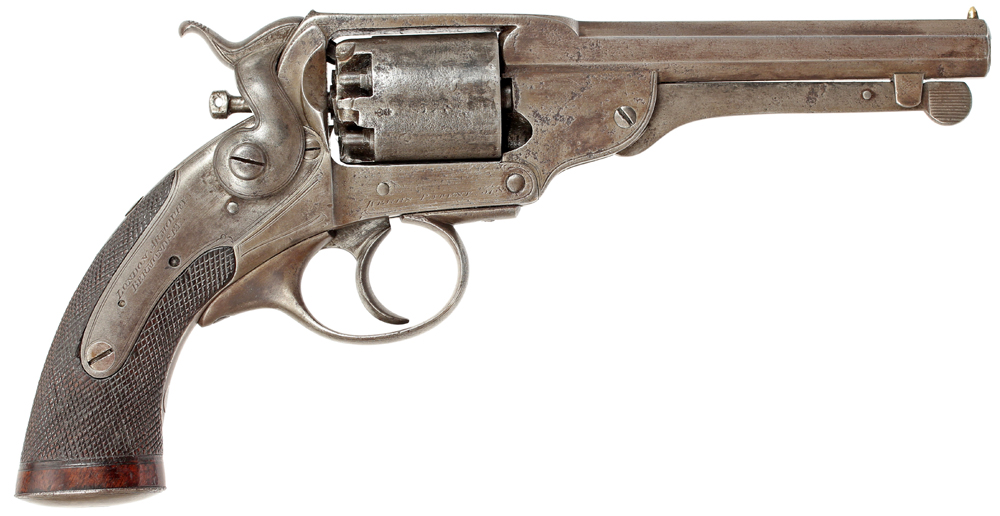 ARIZONA SWORDS
ARIZONA SWORDS 
 ARIZONA SWORDS
ARIZONA SWORDS 
Enfields-Revolvers-Muskets
CLICK BELOW BUTTONS TO SEE AVAILABLE ITEMS
Beware of fake and misrepresented edge weapons.
Click above to see examples of known fakes!
***********************************************************************************************************
CLICK IMAGES TO SEE MORE PHOTOS
******************************************************************************************************************************
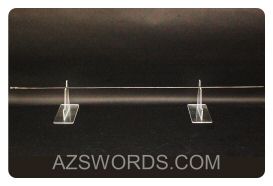 |
 |
RROD01. SERIAL NUMBERED - CONFEDERATE ENFIELD RIFLE RAM-ROD: This is a serial number ram-rod for a Confederate Enfield Rifle. It is serial number 6301 and is 38 3/4 inches long. This number places it in the range of the 500 guns produced by James Kerr. Kerr Enfield rifles represent slightly less than 2% of the total delivered and to date only 6 of the 500 P-1853s delivered by James Kerr are known to still exist. The Enfield rifle with this number is one of those surviving examples, but the whereabouts is unknown. It has the same serial number and is “K” marked forward of the butt plate with a JS-Anchor worn off. If you have this rifle let me know. Shipping & Insurance is included. $1900.00
******************************************************************************************************************************
F279. CONFEDERATE 1853 ENFIELD RIFLE - DOUBLE MARKED SINCLAIR, HAMILTON & COMPANY ON STOCK AND OVAL SHC MARKED BARREL: During the Civil War, a large number of 1853 Enfield Rifle Muskets were supplied by the Sinclair, Hamilton & Company. This Confederate 1853 3-band Enfield is in excellent condition with double Crown SHC marks on the stock and the rare Oval SHC mark on the barrel. The stock has expected ding, but no major issued; the metal has an even deep rich brown patina, and the rifling is strong. The action properly functions and hold in both half and full cock, and the nipple and protector are original as is the ram-rod. The barrel is proof marked * 24 * 24 * and has the rarely seen Oval SHC stamp. The lock is dated 1861. This is an early Enfield that no doubt saw action. $3100.00
******************************************************************************************************************************
F314. LONDON ARMOURY COMPANY MILITARY CONTRACT P-1853 ENFIELD RIFLE: The London Armoury Company was established in 1856 with the sole intention to produce military pattern arms for the British War Department, as well as the export market. The high quality, interchangeable part guns from L.A.C. were very desirable acquisitions for both the US and CS during the American Civil War, and both sides attempted to arrange to buy as many of these first-class muskets as possible. London Armoury P-1853 Enfield rifles of any type are very difficult to find, and those with any Civil War provenance or markings are particularly hard to located and extremely desirable. Military contract London Armoury P-1853s are relatively rare as well, due to the limited production of the gun when compared to the total numbers of Enfield rifles acquired by the British military during the 1860s. Early contract dated guns, made in 1861, are particularly hard to find in decent condition as the London Armoury guns were designated as a “First Class’ arms by the regular army and often saw hard use.
This London Armoury P-1853 Enfield Rifle Musket is a scarce example of an early produced military gun dated 1861. It is clearly marked in two lines on the lock 1861 / L.A. Co. with the usual (British Crown) / VR to the rear of the hammer, and the British Crown Arrow mark. The lock is plain, without engraved boarder lines and has a plain hammer without feathers. The breech of the gun is marked with a pair of L.A.C. as well as the usual British military Proof, View & Definitive Proof, and inspection marks of a Crown over the number of the inspector. The barrel has the original L.A.C. marked rear site; original barrel bands; front site; all which have a pleasing plum-brown patina. The ram-rod is original to the gun, as are the sling swivels. The bore has good rifling with no pitting. The stock shows the usual minor scattered bumps, dings, dents and handling marks you expect to find on a 150-year-old military long arm, but no breaks or repairs. It retains crisp checkering at the wrist and forearm and shows minor handling wear, and is stamped with the round London Armoury Company mark: LONDON ARMOURY / BERMONDSEY around the date 1861 in the center on the buttstock. There is also a silver wrist escutcheon with the engraved Old English script initials "WSS"; however, it unknown to whom these letters belong. This is a 100% complete and correct example of a scarce London Armoury Company produced Pattern 1853 Enfield rifle musket. It is a very desirable gun to add to any Enfield or Confederate rifle collection. The gun is in wonderful condition and is extremely attractive. Shipping & Insurance is included. $2300.00
******************************************************************************************************************************
F333. CONFEDERATE - PATTERN 1856 SHORT RIFLE – "COMMERCIAL VARIANT": This Confederate Pattern 1856 Short Rifle is referred to as a "commercial variant" because of the brass butt plate and the four - groove barrel. The original bayonet bar with the extended key was period removed, but you can still see its silhouette, and there is no rear site. The barrels dark patina indicates this gun has been this way for a long time and is totally original. The stock is all original and never sanded, and the Sinclair, Hamilton, & Company viewers mark “Crown over block “SH” / “G3” is forward of the butt stock. On the flat opposite the lock is a faint second Confederate mark: Script “J.C” within and Oval. The lock is marked TOWER 1862 with a CROWN and no British proof marks. The action holds in both half and full cock, the nipple is period original, and the rifling is strong. There are no sling swivels. “Crown over block “SH” / “G3” is not often seen on Pattern 1856 rifles and is very unique. Shipping & Insurance included. $2500.00
******************************************************************************************************************************
BARREL PROOF MARKS
F364. PATTERN 1856 ENFIELD 2-BAND RIFLE: The Pattern 1856 Enfield 2-band rifle was purchased by both the North and South during the Civil War, and without certain markings it is hard to know which side carried this gun. It is complete with all original barrel band, sling swivels, adjustable real site, steel butt plate and trigger guard, and ramrod. The lock is TOWER marked and dated 1861 with a CROWN and no British governments markings, and properly functions in both half and full cock; and the nipple is original. The stock has expected dings and bumps and is complete with no breaks, and is maker marked T. TURNER. Also, to the real of the trigger guard and swivel is stamped a faint CROWN and B S A for the Birmingham Small Arms Company Limited (BSA). All the steel has the same matching plum-brown patina. The barrel rifling is gone and is a smooth bore, which is common for a gun that saw heavy use. The barrel proof marks for this gun are not on the side, but on the underside of the barrel. Shipping & Insurance included. $1800.00
******************************************************************************************************************************
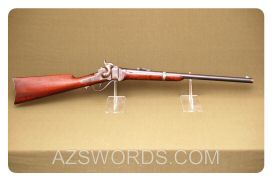 |
 |
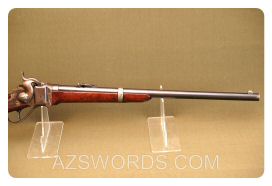 |
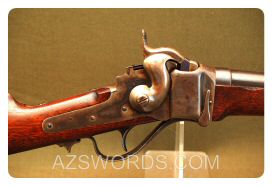 |
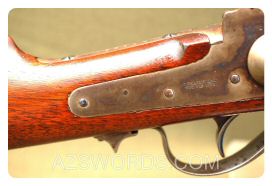 |
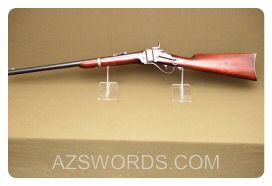 |
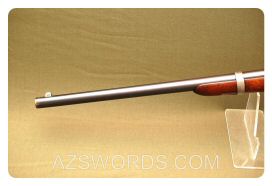 |
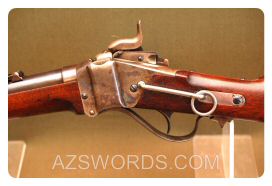 |
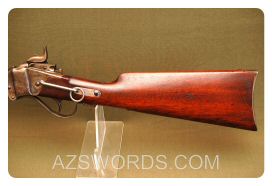 |
 |
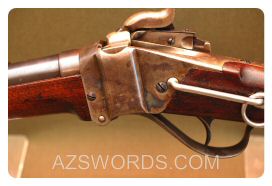 |
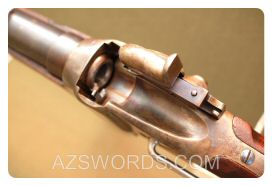 |
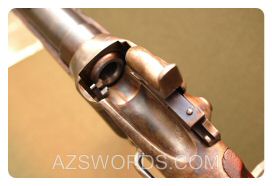 |
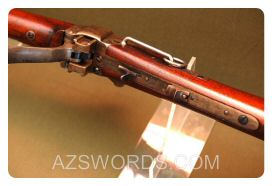 |
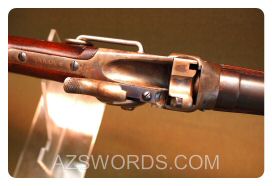 |
 |
 |
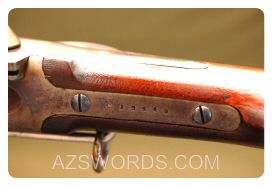 |
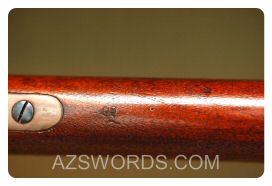 |
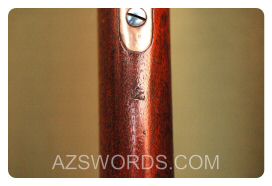 |
“Z”
F379. RARE! - CONFEDERATE CAPTURED, CLEANED & REPAIRED NEW MODEL SHARPS, UNION RECAPTURED AND POST WAR CONVERTED TO .50-70 CARBINE: This is an extremely rare Civil War & Post War Sharps Carbine. It originally started as a New Model Sharps and was issued early in 1865 to union troops, was Confederate captured and went through the Clean & Repaired process, butthen Union recaptured and later converted to .50 – 70 in 1868 for Indian War use. The serial number on this gun is C19440. C19358 went to the 15th New York Cavalry and C19543 went to the 8th New York Cavalry, so it is likely this gun when to one of those two units, which where both fighting in Virginia during the advance on Richmond. This Sharps Carbine went through the Confederate C&R (clean, repair) process and has the inspection mark “Z” on the underside to the rear of the trigger tang. This mark is associated with Captain Louis Zimmer, who was involved with Confederate clean and repair operations at Richmond. It is unknown exactly what work was done on the gun during the C & R process, and I doubt the gun was ever reissued to Confederate troops as Richmond fell. The gun is in amazing condition. The barrel is marked New Model 1863 to the rear of the site with faint HARTFORD CT mark to the front. The SHARP maker mark is on the front of the lock with the correct marks on the opposite side. The barrel retains 98% + original finish and has a bright 6-grove bore, and there is a good amount of case-coloring on the gun. The stock is in near-mint condition and there is the post-war cartouche that was applied when the gun was converted to .50-70. There is a small chip on the forearm of the stock, but otherwise also near-mint. From February 1868 to October 1869, approximately 32,190 carbines were switched over to the .50-70 cartridge. The carbines were immediately sent to the 1st, 2nd, 3rd, 6th, 7th, 8th, 9th and 10th Cavalry Regiments in the West. This is an amazing example of a Sharps Carbine which saw action in Virginia during the Civil War, was Confederate captured and Union recaptured, and later converted to .50-70 for Indian War Service. Shipping & Insurance included. $7900.00
******************************************************************************************************************************
F385. RARE - CONFEDERATE HOLSTER & MARTIALLY MARKED SAVAGE NAVY REVOLVER: Confederate holsters are rare to find, and it is even more uncommon to find one for a Savage Navy Revolver. I purchased this directly from Tim Prince of (College Hill Arsenal) and just love its look! The holster is brown leather; complete with the flap, and has the complete back belt loop, but missing the retention button. It is worn at the hammer location and at the bottom where the barrel is visible. The Savage Navy revolver has an even brown patina; is missing the front site; properly cycles; has original grip which have a carved cross over the original cartouche, but does not hold in the full cock position. Shipping & Insurance included. $3100.00
******************************************************************************************************************************
F395. CONFEDERATE ALTERED - HARPERS FERRY 1842 MUSKET - 1845 DATED: This 1842 Harpers Ferry musket is Confederate altered to the size of a 2-band rifle, and once had a Confederate blade site. It is in attic-found condition and has not been cleaned and is all original! The stock is rough with a few splits in the stock near the left side of the barrel, but the wood is strong and not loose. The lock properly functions in both half & full cock position and is dated the same as the barrel;1845. The ramrod is originally for an 1860 Springfield rifle, but was shorten and treaded at its bottom, not just cut down. On the top of the barrel, you can see two groves for a Confederate blade site, which is long gone. There is also is saddle wear on the underside forward of the trigger guard. Shipping & Insurance is included. $895.00
******************************************************************************************************************************
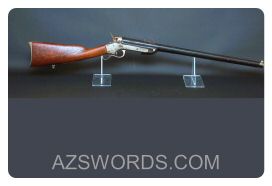 |
 |
 |
 |
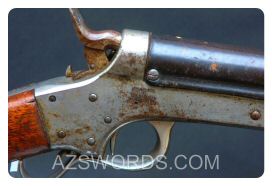 |
 |
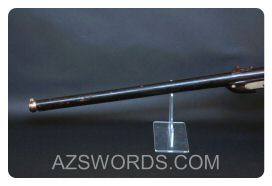 |
 |
 |
 |
 |
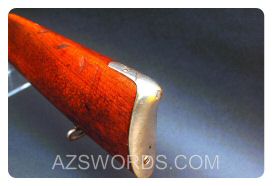 |
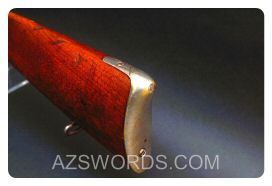 |
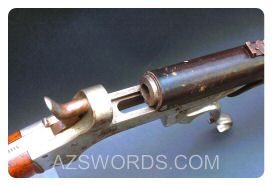 |
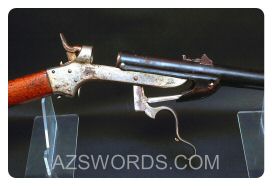 |
F425. SHARPS & HANKINS NAVAL CARBINE: The US M1862 Navy Carbine by Sharps & Hankins, Philadelphia was one of the more interesting and unique arms to see service with the US Navy. Between 1862 and 1865 about 8,000 of these breech-loading carbines were produced. The carbines were produced in .52 rimfire with a unique sliding breech system for loading and unloading. The carbine had a 24” barrel and was rifled with 6 grooves and featured a leather shroud around the barrel to protect the barrel from deterioration due to the salty and highly corrosive environment. Often these leather covers are in very rough condition or entirely missing. Of the 8,000 “Naval” pattern carbines produced, the Navy purchased 6,686. The gun saw extensive use during the American Civil War with the Brown Water Navy gunboats in support of the infantry on the river ways of the south seeing service in the inventory of no less than forty-eight boats and ships. This Carbine is unique not only for the leather cover on the barrel, but the fact that it is factory plated. This was done to protest it while at sea. The stock has expected dings and dents and there is a thin stress fracture on the right side that looks period; however, the stock is strong with no movement. The leather cover is in near-mint original condition and properly attached to the barrel. There is one sling swivel; the gun is serial number 11111 on the tang and barrel; the hammer does not hold in half-cock, but does fully lock. Overall. this is a nice looking and 100% complete example of a relatively rare US Navy carbine. The gun is in tremendously better condition than they are usually encountered in, with a fine leather barrel shroud and crisp markings. This is one of those not to common carbines that is missing from many Civil War carbine and long arm collection and would be a nice addition to any Civil War naval display. Shipping & Insurance included. $2600.00
*****************************************************************************************************************************
F427.ENGLISH - BRITISH PATTERN 1855 ROYAL ENGINEER’S CARBINE - ROYAL SAPPERS & MINERS CARBINE, WITH LANCASTER’S OVAL BORE: In January of 1852, the British Board of Ordnance began taking the first tentative steps towards designing what would eventually become the Pattern 1853 Enfield Rifle Musket. It was the knowledge that a smaller bore rifle musket was necessary to stay competitive with the armies of Europe. The submissions by the various makers were all different calibers and with different patterns of rifling and each used a bullet of their own design, with only constant that the bullet weight was to be about one ounce, a weight considered the minimum for an effective infantry musket. Lancaster’s submission was his “oval bore” design. This was a mechanical rifling system that from all appearances was a smoothbore design. However, the bore was very slightly oval in cross-section with a minor axis of .543” and a major axis of .557” at the breech, which was slightly reduced to .540” and .55” at the muzzle. The bore itself twisted along the length of the barrel, creating mechanical rifling similar to the systems that would be subsequently patented by Sir Joseph Whitworth and Westley Richards. The pitch of the rifling also increased along the length of the bore, in other words the rifling spun slower at the breech and more quickly at the muzzle. The oval bore rifling performed very well in the trials, as did the five-groove design of Wilkinson and the 3-groove design submitted by Enfield. These experimentations resulted in what would become the basic design specifications for the Pattern 1853 Enfield Rifle musket: a 39” barrel secured by three-barrel bands, with a .577” bore, rifled with 3-grooves with a 1:78 rate of twist, weighing in at slightly more than 9 pounds including the socket bayonet, which would incorporate a locking ring. It was further specified that the lock would include a “swivel” (stirrup) so that the mainspring did not bear directly upon the tumbler as it did in earlier designs. The specification regarding a rear sight remained somewhat open to discussion, as several designs had been submitted, several of which were quite good. Interestingly the rifling pattern was not completely established either, for although the initial specifications called for the three-groove bore of Enfield design, the performance of the Lancaster and Wilkinson pattern rifling left significant doubt in the minds of the Small Arms Committee as to whether the correct decision had been taken as to the style of rifling to be use. A bullet design, which was a collaboration of William Pritchett and William Metford, was adopted for use in the nominally .577 bores of the guns. In January of 1853, an order for 1,000 of these newly specified rifle muskets, 500 with one pattern or rear sight and 500 with another, was placed, in order to begin real field trials of the weapon. In the end the sight designed by Charles Lancaster became the rear sight that we are familiar with on the Pattern 1853 Enfield today. The result of the committee’s lack of confidence that they had “chosen wisely” regarding the rifling system was readily apparent in early 1853, when Wilkinson and Lancaster were both asked to submit Pattern 1853 Enfield Rifle Muskets that conformed exactly to the pattern as was newly adopted, with the only exception being the rifling of the bores, which were to be of the two makers’ patent designs. In June of 1853, the trials of the three rifling systems began and the Lancaster oval bore shot better than either of its competitors. Initially, Lancaster asked to have his guns fired with his own cartridges that used specially sifted powder. However, it was soon discovered that the standard British military service load with standard service powder and the 530 grain Metford-Pritchett bullet shot better in the Lancaster gun than his own specially designed cartridge! Wilkinson insisted on using his own proprietary cartridge as well and did not acquiesce to the use of the standard service load during testing. The result of testing the three systems at 500 yards, aimed at a 6’ foot target resulted in the Lancaster rifling system placing all shots in a 4’ group, while the Enfield rifling could only keep 75% of the shots on target at that distance. The Wilkinson system fared far worse, failing to reliably keep shots on the 6’ target at 200 yards! The results of the testing were so promising that an additional 20 oval bore P1853s were ordered from Lancaster for further evaluation by the Committee on Small Arms. In addition, it was decided to issue the available 3-groove P1853s very sparingly, in the event that Lancaster’s system was eventually adopted over the Enfield 3-groove bore. To further indicate that the decision was not yet set in stone, it was ordered that all P1853s in the production pipeline (some 20,000 contract arms) be made smoothbore, pending the final decision regarding the rifling pattern. The additional testing in August of 1853, shooting at distances of up to 800 yards, again showed the superior accuracy of the Lancaster design. However, two issues had raised concerns among the nay-sayers who supported the Enfield pattern rifling. The first was that the increasing spiral of the bore was complicated and difficult to produce, which would make it harder for the various arms contractors (as well as R.S.A.F.) to manufacture the Lancaster patent barrels. The second concern was that the relief at the breech, being slightly larger than the muzzle, could allow a loaded bullet to move forward when the arm was in service, leaving an air gap between the bullet and the powder charge. It was feared that this gap might create an unsafe situation resulting in increased pressures and a burst breech when the gun was fired. Lancaster subsequently performed tests with bullets that were not fully seated, which proved that this fear was unwarranted. However unfounded, the concern would affect further testing of the Lancaster system and in some ways conspired to help it fail.
In late August, five trial P1853 Enfields were set up at Enfield with Enfield made, Lancaster patent barrels. The barrels had a minor axis of .577” and a major axis of .587” and has the standard 1:78” rifling pitch. The barrels did not have the breech relief of the Lancaster made barrels, nor did they use progressive twist rifling, so the rate of twist remained constant through the length of the bore. These five rifles were tested against Lancaster’s submissions and were found to be sorely lacking, with the Lancaster produced rifles placing 99 of 100 rounds in a reasonable group on a 300-yard target, and the Enfield produced oval bores missing the target entirely 68 times at the same distance! Amazingly, this additional confirmation only resulted in additional testing, with the Board of Ordnance’s decision-making process moving with all the speed of a receding polar ice cap! This fourth series of tests of the Lancaster system in 1853 again proved that the oval bore rifling was superior not only to the conventional 3-groove rifling employed at Enfield, but also to the Enfield made version of the oval bore. In these tests, the Enfield “oval bore” showed a tendency to “strip” after a significant amount of firing, what a modern shooter would refer to as the bore being “shot out”, with the rifling being worn beyond the point of serving its purpose. While the Lancaster made rifles did not show this tendency, it was implied that since this defect existed in the Enfield made arms, that “production quality” oval bore rifles, not produced with the same precision as Lancaster’s trial rifles, would suffer the same fate. Thus, a fifth set of tests were performed in November 1853, this time eliminating the Enfield made oval bores and once again putting the Lancaster oval bore in a head-to-head competition with the 3-groove Enfield. This last series of tests for 1853 showed that even Lancaster’s well-made guns, after a significant amount of firing, began to “strip” as the Enfield made versions had. The report noted that no visible (or even measurable) deterioration was noted, but that after repeated firing the accuracy of the guns gradually eroded. It appears that the Small Arms Committee was performing the tests with the same five trials rifles that had been supplied that summer, and it was likely at this point that thousands of rounds had been fired through the guns. Amazingly, this report resulted in a new series of tests in early 1854. This sixth test required more than 1,000 rounds to be fired from a single Lancaster oval bore rifle musket versus a standard Enfield P1853. As had been discovered in the final testing at the end of the previous year, the Lancaster system began to “strip” and the accuracy degraded over time. The reason for the failure could not be discovered, and as the oval bore system was so much more accurate than the 3-groove system when the bore was new, the supporters of Lancaster’s design lobbied for another test (the seventh) in February of 1854, with the results being the same. At this point, it appears that serious pursuit of the Lancaster rifling system by the Small Arms Committee was abandoned. However, only a year later, Lancaster’s design was adopted for limited production and issue to the Royal Engineer Corps, as the Pattern 1855 Royal Engineer’s Carbine, or more commonly as the Royal Sappers & Miners Carbine, with Lancaster’s Oval Bore. So, as we can see the oval bore concept was far from dead and still had several supporters with the small arms and ordnance communities. The Pattern 1855 Royal Engineer’s Carbine looks very much like the Pattern 1856 Enfield “Short Rifle” at first glance. The brass mounted rifle had a 31.5” round barrel, secured by two clamping barrel bands and was nominally 48” in overall length. A bayonet lug to accept a saber bayonet was mounted to the barrel, near the muzzle. Like most variants of the shorter “Enfield” pattern long arms, the lower swivel was mounted in the toe of the stock and the upper swivel was attached to the upper band. While the 1.5” difference in length between the barrels of the Royal Engineers “Sappers & Miners” carbine and the Pattern 1856 short rifle is not immediately noticeable, the mounting of the rear sight “backwards” from the conventional direction on the Lancaster guns is a quick identifying feature. Due to Lancaster’s control of the patent, he managed to be the only contractor to produce the military contract Royal Engineer’s Carbines from their adoption through November of 1858. After that time, contracts were let to the various Birmingham and London makers who could produce the gun. However, the guns were never acquired in large numbers as their issue was to a very specific and small branch of the British military. Despite the limited production for British military use, the outstanding accuracy of the Lancaster design found favor with the British “Volunteer” movement.
Offered here is a GOOD condition example of a scarce Pattern 1855 Royal Engineer’s Carbine. The gun is clearly marked on the lock, in two engraved lines: C. LANCASTER’S / PATENT. The barrel is further engraved: 151 NEW BOND ST LONDON. The barrel measures 31.75”; the top of the barrel is stamped with the usual London commercial view, proof and definitive proof marks, as well as the gauge mark 25, indicating a nominally .577 bore. The “carbine” has the correct pattern leaf rear sight that is mounted in reverse with the 1000-yard graduations on the bottom of the leaf, so they are seen by the shooter when it is lifted. The original front sight, an improved version of the standard military “block and blade” sight, is present near the muzzle. The saber bayonet lug is of the correct Pattern 1856 “Type I” pattern with a .75” key forward of the main lug. The exposed iron surface shows light pitting, but it is under a deep brown attractive patina. The lock has a slightly mottled plum brown and gray patina, with double boarder line engraving that remains clear and sharp, as does the engraved Lancaster information. The lock is mechanically excellent and functions perfectly. As noted, the original rear sight and front sight are present, as is the original bayonet lug, the original full-length ramrod and both sling swivels. Even the original screw protecting “doughnuts” are present at the ends of the tension screws for the two Palmer pattern clamping bands. All of the brass furniture from the buttplate to the nose cap has a smooth patina that matches the balance of the gun well. The stock is in about VERY GOOD condition and is made from an attractive and nicely figured piece of walnut. The stock is solid, full-length, and complete and free of any repairs, breaks, with a few hair-line cracks near the butt-plate. The stock retains very good line and edges and does not appear to have been sanded. Overall, this is a very attractive, 100% complete and correct example of a commercial or “Volunteer” version of the Pattern 1855 Royal Engineer’s Carbine. Shipping & Insurance included. $2100.00
*****************************************************************************************************************************
 |
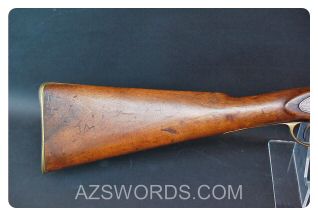 |
 |
 |
 |
 |
 |
 |
 |
 |


F430. LOUISIANA PURCHASED 1853 ENFIELD RIFLE – CONFEDERATE ARSENAL MODIFIED to COMBAT SHOTGUN: During the Civil War, the South recovered weapons and other military items off the battlefield to be refurbished and reused. For those weapons being restored to original condition, the Clear & Repair system in Richmond was utilized. However, there was another earlier system established to convert some guns for a purpose other than originally designed. Many full-sized guns were cut-down and smoothed bored making them into shotguns to use buck & ball ammunition. Buck-and-ball was a common load use by Confederates and consisted of a large caliber lead musket ball combined with three to six buckshot pellets. This was not a post-war conversion, but done early in the war. This Enfield is one of the rare ones purchased by the State of Louisiana. These did not have serial numbers, but were stamped with a six-point star with a circle L in the center, and the mark is found on the underside of the stock to the rear of the trigger guard. The stock on this gun is cut back to the first band. The barrel is reduced to 30 1/4 inches and smooth bored, and the rear site was removed and a notch was cut for a front site. There is no rear swivel, and the lock is marked with a Crown & 1861 over TOWER and it properly function. A Louisiana surcharged Enfield is rare in any condition, and at the December show in Franklin, I saw a full-size example priced for $14,000. This is available at a much more reasonable priced. Shipping & Insurance is included. $1900.00
******************************************************************************************************************************
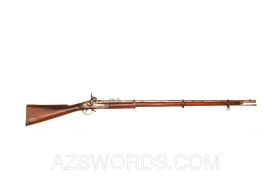 |
 |
 |
||
 |
 |
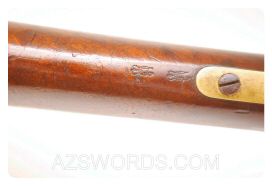 |
 |
F432. CONFEDERATE PATTERN 1853 ENFIELD RIFLE: This is a double marked Crown SHG1 Confederate Pattern 1853 Enfield Rifle. The Crown SHG1 is a viewer mark believed to be used by Sinclair Hamilton & Company, and not often seen. On the stock forward of the butt plate tang is stamped K 3, which most likely is a unit designation. The stock shows normal dings and wear, but overall is in great condition. The lock is marked CROWN / 1862 / TOWER and properly functions, and hold both half and full cock. The nipple is original. The barrel has strong rifling, but is bright from being cleaned. However, the barrel bands, which are all marked with the number 5, have a brown patina. The ramrod is original as well as both sling swivels. Shipping & Insurance included. $2500.00
******************************************************************************************************************************
F439. CONFEDERATE - SOUTH CAROLINA - 1853 ENFIELD RIFLE: This is a Confederate 1853 Enfield Rifle identified to the state of South Carolina. It is a Barnett London made gun with a London marked barrel that has the Sinclair Hamilton Company – Oval marks on the top of the barrel; and forward of the butt-plate tang is a small S.C for the state of South Carolina. Several other guns with this small mark have been found, but it is not known if it was applied before the guns were shipped or after they arrived in South Carolina. The stock is strong with expected dings and bumps and all the steel has a pleasing patina; the bore is bright and has sharp rifling; all barrel bands are original; both sling swivels are present and the action holds in both half and full cock positions. Overall, an excellent example of a S.C marked Confederate 1853 Enfield. Shipping & Insurance included. $2700.00
******************************************************************************************************************************
“Z”
F453. CONFEDERATE “Z” MARKED CCR BURNSIDE CARBINE: This is a 5th model Burnside Carbine, which was Confederate captured and has the letter “Z” on the underside, forward of the trigger tang, which means this gun went through the “C&R” Clean & Repair process at the Richmond Arsenal/Artillery Work-shop, and inspected by Lous Zimmer. The stock is in good condition with some wood lose near the hammer tang. The metal has a mottled gray patina; The lock properly functions; the bore is bright with strong crisp rifling; both the sling swivel and carry ring are present; and the front and rear site are original. The lower and upper receiver has matching serial number 33724. The “C&R” inspection letter “Z” is to the rear of the trigger tang. Shipping & Insurance included. $2900.00
******************************************************************************************************************************
 |
 |
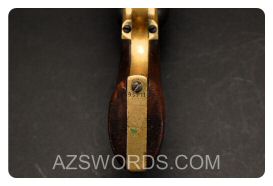 |
 |
 |
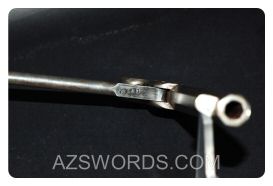 |
 |
 |
 |
 |
![]()
![]() F462. HARTFORD COLT MODEL 1851 NAVY REVOLVER
- BRASS FRAME - 1858 PRODUCTION: This is a Colt Model 1851
Navy Revolver – Hartford CT. It is serial number 86301 and described by Colt records as an 1851 Navy .36
Caliber with Naval Engravements in Cylinder, Octagonal barrel made in the year 1858. The gun is complete and fully functional and tight. The serial number matches on all parts to include the loading lever; wedge; cylinder;
lower and upper frames; trigger guard and backstrap. No cylinder scene remains,
and I suspect the gun was re-worked on at a Confederate arsenal because there
are three dots stamped on the cylinder not seen on Union guns, and the silver
blade front site. The grip is original as well as all screws, and on the
underside of the grip are carved the initials “W K” in the brass which also extended into the wood. The gun
has a pleasing gray patina. Many of the 1858 dated Hartford Colt Navy revolvers were in Southern arsenals at the onset the Civil War. Shipping & Insurance included. $2500.00
F462. HARTFORD COLT MODEL 1851 NAVY REVOLVER
- BRASS FRAME - 1858 PRODUCTION: This is a Colt Model 1851
Navy Revolver – Hartford CT. It is serial number 86301 and described by Colt records as an 1851 Navy .36
Caliber with Naval Engravements in Cylinder, Octagonal barrel made in the year 1858. The gun is complete and fully functional and tight. The serial number matches on all parts to include the loading lever; wedge; cylinder;
lower and upper frames; trigger guard and backstrap. No cylinder scene remains,
and I suspect the gun was re-worked on at a Confederate arsenal because there
are three dots stamped on the cylinder not seen on Union guns, and the silver
blade front site. The grip is original as well as all screws, and on the
underside of the grip are carved the initials “W K” in the brass which also extended into the wood. The gun
has a pleasing gray patina. Many of the 1858 dated Hartford Colt Navy revolvers were in Southern arsenals at the onset the Civil War. Shipping & Insurance included. $2500.00
*****************************************************************************************************************************
F469. CONFEDERATE BROWN LEATHER HOLSTER & 1858 - HARTFORD COLT 1851 NAVY REVOLVER: Prior to the outbreak of the Civil War, many of the Confederate states purchased Hartford Colt 1851 Navy revolvers in preparation for hostilities. Unfortunately, Colt archive records are incomplete and it is difficult to know where many of these early guns were shipped. However, sometime they are discovered with an original Confederate brown-leather holster supporting the fact it was a Confederate carried revolver. I purchased this from Brian “Rebel Relic” Akins who told me it was discovered in Tennessee. It is a Hartford Colt 1851 Navy revolver, serial number 89744: production year 1858. It is a steel frame gun with matching serial number on all parts except the period replaced wedge and the unnumbered steel backstrap. The original grips have been period checkered with a diamond in the center on both sides. The action is soft, but properly function and holds in both half and full cock positions. The brown-leather Confederate holster is in near-mint condition and has form fitted to the revolver. It is complete with a re-enforced toe and near 100% original stitching. The flap is complete and secures to a brass stud, and the backstrap is held in place with five brass rivets. The high quality of the holster may indicate it belonged to an officer, and would be priceless if the revolver were a Griswold or other Confederate made gun. Shipping & Insurance included. $2400.00
******************************************************************************************************************************
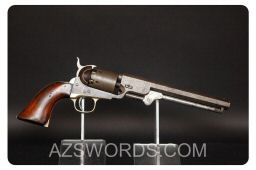 |
 |
 |
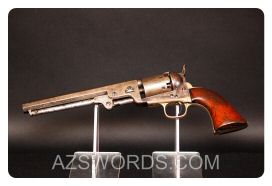 |
 |
 |
 |
 |
 |
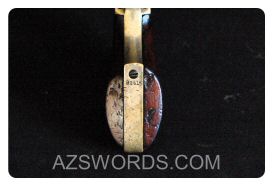 |
F470. HARTFORD COLT MODEL 1851 NAVY REVOLVER - BRASS FRAME - 1860 PRODUCTION: This is a Colt Model 1851 Navy Revolver – Hartford CT. It is serial number 93415 and described by Colt records as an 1851 Navy .36 Caliber with Naval Engravements in Cylinder, Octagonal barrel made in the year 1860. The gun is complete and fully functional and tight. The serial number matches on all parts to include the loading lever; wedge; cylinder; lower and upper frames; trigger guard and backstrap. The cylinder has traces of the original naval scene grip and the is a good amount of original blue on several screws. It has the original brass front site, and strong rifling; and has a pleasing mellow gray patina with light traces of silver on the brass. 1860 dated Hartford Colts Model 1851 Navy Revolver are hard to find because many were purchased by Southern states prior to the outbreak of the Civil War and saw heavy service. This is an outstanding example! Shipping & Insurance included. $3600.00
*****************************************************************************************************************************
F472. HARTFORD COLT MODEL 1851 NAVY REVOLVER - STEEL FRAME - 1861: This is a Hartford Colt Model 1851 Navy revolver, Steel Frame, produced in 1861. The serial number 100630 is marked on all parts to include the wedge, cylinder, and frame. It has an even chocolate brown patina; properly functions; has original grip and is tight. Included is the Colt Historical letter which documents this gun was shipped on May 3, 1861 to J.P Moores Son, New York, New York in a lot of 25 guns. More then likely this revolver was carried by an officer from the state of New York. Shipping & Insurance included. $2900.00
*****************************************************************************************************************************
“T”
F482. ORIGINAL CONFEDERATE PATTER 1853 ENFIELD RIFLE, BATTLE FIELD RECOVERED & C&R “T” MARKED: This is an original purchased Confederate Pattern 1853 Enfield Rifle with a faint Sinclair Hamilton & Company viewer mark to the rear of the trigger tang, and a “T” Clear & Repair inspected mark forward of the trigger tang. The rifle was Confederate recovered off a battlefield; sent back to Richmond and went through the C&R Clean & Repair system. The steel has a pleasing brown patina; all barrel bands are original; the lock property functions with a repaired bolster; the ramrod isoriginal; but the rear site is gone and it is smooth bored. I have noted that all the rifles and carbines I have seen with the “T” inspection mark have been refinished with a lighter, almost maples, finish. Shipping and Insurance included. $3100.00
*****************************************************************************************************************************
 |
 |
 |
 |
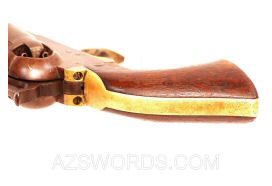 |
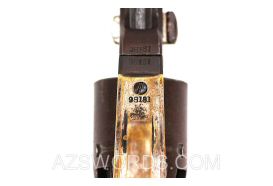 |
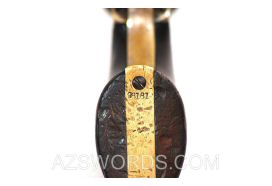 |
 |
F483. HARTFORD COLT M1851 NAVY REVOLVER- 1861 PRODUCTION: This is a Colt Model 1851 Navy Revolver – Hartford CT. It is serial number 98181 and identified as an 1851 Navy .36 Caliber with Naval Engravements in Cylinder, Octagonal barrel made in the year 1861. The gun is complete and fully functional and tight. The serial number matches all parts to include the loading lever; wedge; cylinder; lower and upper frames; trigger guard and backstrap. The grip is original as well as all screws, and there are traces of silver around the trigger guard. The gun has a pleasing plum-brown patina. Many of these 1861 dated Hartford Colt Navy revolvers found there way South. Shipping & Insurance included. $2900.00
*****************************************************************************************************************************
F493. 4TH MODEL TRANTER REVOLVER: This is a Tranter Patent 4th Model, single trigger percussion revolver. The 4th Model Tranter revolver, which were introduced in 1856, used a single trigger and had what would today be called a conventional “double action” lock. It had a 6-inch barrel with a .54 caliber bore; a 5-round cylinder; and a one-piece checkered walnut grip. Dating Tranter revolvers based upon their serial numbers is somewhat problematic, as frames were sometime produced in advance and the guns completed at a later date. What we do know is that the “T” serial number suffix came into use around serial number 2200, sometime between 1854 and 1856. Most of the New Orleans retailer marked Tranters appear in the 8,XXX to 11,XXXT-suffix range and are most likely from the 1856-1860 production period.
This revolver is in very nice condition and is serial number 9769 T, which falls within the New Orleans retailer range. It is complete and properly functions with near-perfect grips with a small chip at the top on the right side. The bore has strong rifling and it is London retailer marked on the top and Tranter marked on the frame and loading lever. Overall, this is an attractive example of a large frame 54-bore 4th Model Tranter percussion revolver. The gun is 100% complete and original in every way. If you have been wanting to add a very nice condition Civil War era Tranter revolver to your collection, this revolver offers the opportunity to purchase a likely Confederate imported gun. $2800.00
******************************************************************************************************************************
 |
 |
 |
 |
 |
 |
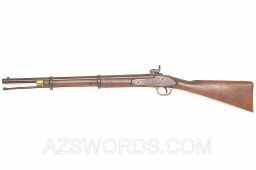 |
 |
 |
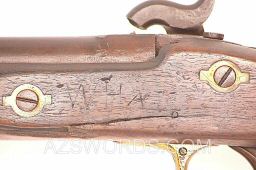 |
 |
 |
 |
 |
 |
 |
 |
 |
F507. CONFEDERATE – PATTERN 1853 ARTILLERY CARBINE: This is a Confederate Pattern 1853 Artillery Carbine, which saw heavy use. It has a CROWN over TOWER / BARNETT LOUNDON lock that properly function in both half & full cock. The original nipple is blown off; the stock has wood lose behind the hammer; there is a large gap from the back of the barrel to the stock with a period repair with pins behind the barrel tang; a period replaced hammer held with a brass screw; a hickory wood field made ram-rod; and forward of the brass butt plate tang is the Confederate Circle S L viewer mark. Also, the bore is shot out. The rear folding site is missing, but you can see where it was and the front site is original as is the bayonet lug. The stock has a few stress fractures, but is strong, and on the flat opposite the lock are the faint initials TWP and the name W.HALL. There are too many Confederate soldiers with these initials and name to make a positive identification, and there is a third set initials TEB over the date 1871. Confederate Pattern 1853 Artillery carbines are rare, and this one saw a lot of action. Shipping & Insurance included. $3700.00
I do have a period and correct Pattern 1853 Artillery Carbine ram-rod that fits and will be sold first with this gun. $350.00
*****************************************************************************************************************************
F511. IVORY GRIP COLT MODEL 1860 ARMY REVOLVER – RECONSTRUCTION PERIOD: This ivory grip Colt Model 1860 Army Revolver is serial number 170662, which places it in the year 1868 right at the beginning of Reconstruction; the period after the Civil War when the former Confederacy was reintegrated into the United States.
The Military Reconstruction Act of 1867 divided the former Confederacy into five military districts, and the U.S. Army played a key role by enforced laws, protected freed slaves, protected polling sites and registered voters, and enforced laws that protected the voting rights and safety of African Americans.
This revolver is all original with matching serial number 170662 on all parts to include the cylinder, wedge and steal back strap. The grips show the expected wear, shrinkage, and stress fractures common to period ivory, but no breaks and are tight. The frame and cylinder have an even gray patina; the action is tight and properly functions, the bore has strong rifling; there remains a good amount of cylinder scene; and the brass trigger guard has traces of original silver wash. Shipping & Insurance included. $3600.00
*****************************************************************************************************************************
 |
 |
 |
 |
 |
 |
 |
 |
 |
 |
 |
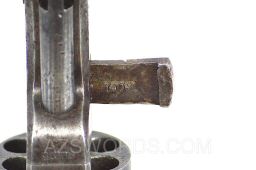 |
F513. 1860 - HARTFORD COLT MODEL 1851 NAVY REVOLVER: This is a Hartford Colt – Model 1851 Navy revolver made in 1860. The serial number #97003 matches on all parts except the cylinder which is #96703. With the last three numbers on the cylinder being 703 and the last four on the gun being 7003, there is a high probability this was a factory error since Colt was quickly filling contracts for shipments to Southern states. Then again, it could have been switch in the field. Both serial numbers are from the 1860 production year. Many of the 1860 Hartford Colt revolvers were sold to Southern states and this gun is well within the ranges of known examples that went to South Carolina, Mississippi, and Louisiana; however, the Colt recorded for this gun were destroyed in a fire. Even still, it is highly probable this was a Confederate carried revolver.
The gun is complete and properly functions. The grips are tight and complete; all screws are original; the bore shows wear but the rifling is still present; and there is still some silver finish present in the trigger guard area. Hartford Colt 1850 Navy Revolver are very desirable, especially those made in 1860. Shipping & Insurance is included. $2250.00
******************************************************************************************************************************
 |
 |
 |
 |
 |
 |
 |
 |
 |
 |
 |
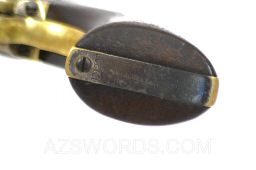 |
CLICK THE ABOVE ICON TO READ THE COMPLETE HISTORY
F515. GETTYSBURG IDENTIFIED – COLT MODEL 1851 NAVY REVOLVER: This Colt Model 1851 Navy Revolver is identified to John J. Magrath of the New York 4th Independent Battery who later served with “L” Co. New York Engineer. The gun is all original with serial number 101206 on all parts to include the wedge. It is a Hartford CT Colt made in 1861. The grip is original with a brass back-strap and trigger guard that have traces of original silver wash, and all screws are original. The name J. J. Magrath. is stamped on the bottom of the grip below the serial number and on the right side in the brass above the trigger. He is the only soldier with this name listed in the Civil War data base.
Private Magrath enlisted on 9/16/1861 at New York City, NY as a Private and was with the New York 4th Light Artillery from 16 October, 1861 to the battery was disbanded December 4, 1863. His muster sheets show he was present for this entire time, which places him on the following battle fields: Siege of Yorktown; Battle of Williamsburg; Battle of Seven Pines or Fair Oaks; Malvern Hill; Battle of Groveton (Brawner Farm); Second Battle of Bull Run; Battle of Fredericksburg; Battle of Chancellorsville; and Battle of Gettysburg. At the Battle of Gettysburg, four guns were posted on the height above Devil’s Den. Included with the gun is a 71-page binder with historical information; click on the above New York to read the details. Shipping & Insurance is included. $6600.00
*****************************************************************************************************************************
 |
 |
 |
 |
 |
 |
 |
 |
 |
 |
 |
 |
F516. SHARPS CARBINE - CONFEDERATE CAPTURED, CLEANED & REPAIRED: This Sharps Carbine went through the Confederate C&R (clean, repair) process and has the inspection mark “Z” on the underside to the rear of the trigger tang. This mark is associated with Captain Louis Zimmer, who was involved with Confederate clean and repair operations at Richmond. The mark is faint indicating the gun was reissued to a Confederate soldier and most likely saw some action. The original serial number is 97222. The gun is in great shape with nice dark walnut stock and forearm and an even patina on all metal parts, and the original patch box. The Confederate C&R guns are very collectable, as well as affordable, compared to a Richmond rifle or carbine. Free Shipping & Insurance. $3600.00
******************************************************************************************************************************
CLICK THE ABOVE ICON TO READ THE COMPLETE HISTORY FOLDER
F517. 12TH INDIANA INFANTRY CARVED & IDENTIFIED CIVIL WAR MUSKET: This is a wonderfully identified Remington Maynard tape primer conversion 1816 musket with a long-range rear sight. While in the field, the soldier carved his name and unit into the left side of the stock. Nicely carved is ... C. A. Lewis Co. F 12th Reg I. V. ... This is Clark A. Lewis of Allen County, Indiana. He enlisted on 5/11/1861 as a Private and he was Mustered Out on 5/19/1862 at Washington, DC.The musket is solid and mechanically perfect. The sling swivels have been removed and the tape primer door is replaced. Otherwise, all original and complete. Identified Indiana weapons are rare to find considering the population of the state at the time of the Civil War. Shipping & Insurance is free, and a 58-page binder of the unit’s history to include the soldiers muster sheet and pension file is included. $2900.00
******************************************************************************************************************************
 |
 |
 |
 |
 |
 |
 |
 |
F518. AUSTRAIN M1851 CARBINE – TYPE-II: The Austrian M1851 Carbine have long been considered early Civil War Federal purchased, but new information indicates they saw Confederate service as well. Originally designed with the Austrian console (pill lock) ignition system, they were altered to percussion in the late 1850’s. It measures 30” overall with a 14.5” barrel and a .71 caliber bore with distinctive 12-grove rifling. The type-II variant has a Belgian alteration with the bolster on top of the barrel, and no ramrod. The ramrod was carried separately on the soldier’s belt. This gun is in near-mint condition with crisp edges, bright metal, and matching serial numbers. The action is tight and properly functions. This is the finest example I have ever seen! Shipping & Insurance included. $1800.00
******************************************************************************************************************************
 |
 |
 |
 |
 |
 |
 |
 |
 |
 |
 |
 |
 |
 |
 |
 |
 |
 |
F520. COLT MODEL 1851 NAVY REVOLVER (.36 CALIBER WITH NAVAL ENGAGEMENT ON CYLINDER, OCTAGONAL BARREL): This is a Colt Model 1851 Navy Revolver with matching serial number 140585, except for the period replaced wedge: production year 1863. This serial number falls between those issued to the 8th Michigan cavalry.
140576 51N 64 CO K 8TH MICH VOL CAV
140602 51N 65 CO B 8TH MICH VOL CAV
The gun has a brown-gray patina, all original screws; properly function and holds in both half & full cock positions; all original nipples, full naval scene above the cylinder serial number; original grip with a silver inlay of an upward pointing heart. This heart may represent the 24th Army Corp. Shipping & Insurance is included. $2500.00
******************************************************************************************************************************
 |
 |
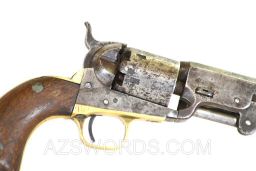 |
 |
 |
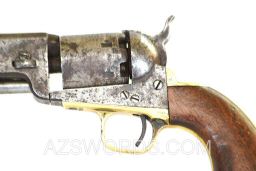 |
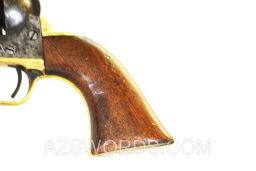 |
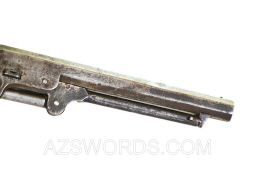 |
 |
 |
F521. COLT 1851 NAVY REVOLVER (.36 CALIBER WITH NAVAL ENGAGEMENT ON CYLINDER, OCTAGONAL BARREL: This is a Colt Model 1851 Navy Revolver with matching serial number 175959: production year 1864. All parts to include the cylinder and wedge have matching numbers. This gun saw use and has an even gray patina. The action is tight and hold both half & full cock positions and properly functions. It has the original grip; screws and nipples but little cylinder scene, and there are two areas on the grip that have lead applied. Shipping & Insurance included. $1995.00
******************************************************************************************************************************
 |
 |
 |
 |
 |
 |
 |
 |
 |
 |
F522. COLT 1851 NAVY REVOLVER (.36 CALIBER WITH NAVAL ENGAGEMENT ON CYLINDER, OCTAGONAL BARREL: This is a Colt Model 1851 Navy Revolver with matching serial number 127682-2: production year 1863. The gun has lots of original blue as does the wedge, which is original to the gun, but was factory struck several times caused the last digit to look like an 8. The gun has much original blue on the upper barrel receiver, and a pleasing light brown patina on the lower receiver and cylinder with some traces of blue. All screws are original, and the cylinder retains much of the original scene. The grip is original and has several hash marks on the bottom wood. The backstrap has traces of gold wash, and what appears to be the remnant of a presentation or identification, and a partial date 23, 1863 on the underside brass. These marks are faint and best visible with magnification and are difficult to photograph. These marks are faint and best visable with magnification. The gun was obviously carried and the information was worn away. Colt research center might have more information on this gun and it may be worth the extra $350.00 they charge to see what they know. Shipping & Insurance is included. $3800.00
******************************************************************************************************************************
 |
 |
 |
 |
 |
 |
 |
 |
 |
F523. COLT MODEL 1860 ARMY REVOLVER (.44 CALIBER WITH NAVAL ENGAGEMENT SCENE ON CYLINDER) All MATCHING NUMBERS: This is a Colt Model 1860 Army revolver, .44 caliber with naval engagement scene on cylinder and all matching numbers to include the wedge and cylinder. It has an 1863 serial number 134691, and faint cartouche marks on both grips. On SEP 09, 1863, the New York Arsenal Governor's Island, NY received 1000 Colt 1860 Army revolvers and this gun was within the range of this shipment. The gun has a gray-brown patina; has all original screws; properly functions and holds both in half & full cock position; all original nipples; and traces of original cylinder scene. Shipping & Insurance is included. $1995.00
******************************************************************************************************************************
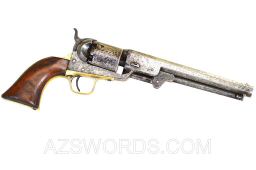 |
 |
 |
 |
 |
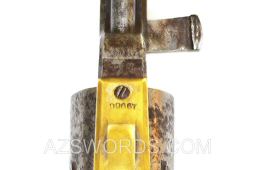 |
 |
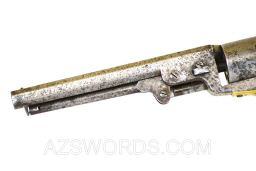 |
 |
 |
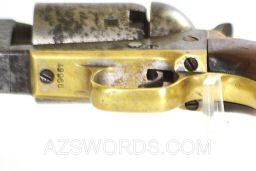 |
 |
F524. HARTFORD COLT M1851 NAVY REVOLVER- 1861 PRODUCTION: This is a Hartford Colt – Model 1851 Navy revolver: production year 1861. Most likely the gun was made at the end of 1861 because it was sold to the United States Government on January 11, 1861 per the Colt historical records. The gun is compete with all matching serial number 99667 to include the cylinder and wedge. The grips and all screws are original; the action properly functions and holds both half & full cock; the nipples are all original, and the gun has a gray patina. Included is the Office of the Colt Historian letter document the gun beind sold in a lot of 100 to the United States Government and shipped to Colt's Patent Fire-Arms Mfg. Company, New York Office. Shipping & INsurance included. $2800.00
******************************************************************************************************************************
****************************************************************
Remittance by Mail
Send to:
Arizona Swords
530 E. McDowell Road, Suite 107-160
Phoenix, AZ 85004
****************************************************************
Contact Number: (602) 245-4721
© 2004 Arizona Swords azswords.com. All rights reserved in all media.